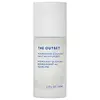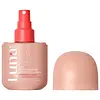What's inside
What's inside
 Key Ingredients
Key Ingredients

 Benefits
Benefits

 Concerns
Concerns

 Ingredients Side-by-side
Ingredients Side-by-side

Water
Skin ConditioningCaprylic/Capric Triglyceride
MaskingPentylene Glycol
Skin ConditioningGlycerin
HumectantEthylhexyl Palmitate
EmollientCetearyl Alcohol
EmollientSqualane
EmollientCassia Angustifolia Seed Polysaccharide
Skin ConditioningHelianthus Annuus Seed Oil
EmollientCocos Nucifera Oil
MaskingCarthamus Tinctorius Seed Oil
MaskingPersea Gratissima Oil
Skin ConditioningHumulus Lupulus Extract
AntimicrobialHelianthus Annuus Extract
EmollientHelianthus Annuus Seed Wax
Skin ConditioningRosmarinus Officinalis Leaf Extract
AntimicrobialAloe Barbadensis Leaf Juice
Skin ConditioningPrunus Insititia Seed Oil
EmollientOryza Sativa Bran Extract
Skin ConditioningFucus Vesiculosus Extract
EmollientLeuconostoc/Radish Root Ferment Filtrate
AntimicrobialLeontopodium Alpinum Extract
Skin ConditioningGlycine Soja Oil
EmollientJojoba Esters
EmollientDicaprylyl Ether
EmollientDiheptyl Succinate
EmollientGlyceryl Stearate
EmollientCarbomer
Emulsion StabilisingPhenoxyethanol
PreservativeCitric Acid
BufferingHydrogenated Vegetable Oil
EmollientXanthan Gum
EmulsifyingPolyglycerin-3
HumectantCaprylyl Glycol
EmollientCapryloyl Glycerin/Sebacic Acid Copolymer
Skin ConditioningTocopheryl Acetate
AntioxidantTocopherol
AntioxidantTetrasodium Glutamate Diacetate
Potassium Hydroxide
BufferingPotassium Sorbate
PreservativeSodium Benzoate
MaskingSodium Formate
BufferingSodium Glycolate
BufferingSodium Hydroxide
BufferingSodium Stearoyl Glutamate
CleansingWater, Caprylic/Capric Triglyceride, Pentylene Glycol, Glycerin, Ethylhexyl Palmitate, Cetearyl Alcohol, Squalane, Cassia Angustifolia Seed Polysaccharide, Helianthus Annuus Seed Oil, Cocos Nucifera Oil, Carthamus Tinctorius Seed Oil, Persea Gratissima Oil, Humulus Lupulus Extract, Helianthus Annuus Extract, Helianthus Annuus Seed Wax, Rosmarinus Officinalis Leaf Extract, Aloe Barbadensis Leaf Juice, Prunus Insititia Seed Oil, Oryza Sativa Bran Extract, Fucus Vesiculosus Extract, Leuconostoc/Radish Root Ferment Filtrate, Leontopodium Alpinum Extract, Glycine Soja Oil, Jojoba Esters, Dicaprylyl Ether, Diheptyl Succinate, Glyceryl Stearate, Carbomer, Phenoxyethanol, Citric Acid, Hydrogenated Vegetable Oil, Xanthan Gum, Polyglycerin-3, Caprylyl Glycol, Capryloyl Glycerin/Sebacic Acid Copolymer, Tocopheryl Acetate, Tocopherol, Tetrasodium Glutamate Diacetate, Potassium Hydroxide, Potassium Sorbate, Sodium Benzoate, Sodium Formate, Sodium Glycolate, Sodium Hydroxide, Sodium Stearoyl Glutamate
Water
Skin ConditioningMethyl Gluceth-20
HumectantCocamidopropyl Betaine
CleansingHeptyl Glucoside
Sodium Chloride
MaskingInulin
Skin ConditioningLactic Acid
BufferingAloe Barbadensis Leaf Juice
Skin ConditioningGlycerin
HumectantLinoleic Acid
CleansingVegetable Oil
Skin ConditioningChamomilla Recutita Flower Extract
MaskingPanthenol
Skin ConditioningPotassium Sorbate
PreservativeCitric Acid
BufferingTocopherol
AntioxidantIngredients Explained
These ingredients are found in both products.
Ingredients higher up in an ingredient list are typically present in a larger amount.
Aloe Barbadensis Leaf Juice comes from leaves of the aloe plant. Aloe Barbadensis Leaf Juice is best known for helping to soothe sunburns. It is also anti-inflammatory, moisturizing, antiseptic, and can help heal wounds.
Aloe is packed with good stuff including Vitamins A, C, and E. These vitamins are antioxidants, which help fight free-radicals and the damage they may cause. Free-radicals are molecules that may damage your skin cells, such as pollution.
Aloe Barbadensis Leaf Juice also contains sugars. These sugars come in the form of monosaccharides and polysaccharides, folic acid, and choline. These sugars are able to help bind moisture to skin.
It also contains minerals such as calcium, 12 anthraquinones, fatty acids, amino acids, and Vitamin B12.
Learn more about Aloe Barbadensis Leaf JuiceCitric Acid is an alpha hydroxy acid (AHA) naturally found in citrus fruits like oranges, lemons, and limes.
Like other AHAs, citric acid can exfoliate skin by breaking down the bonds that hold dead skin cells together. This helps reveal smoother and brighter skin underneath.
However, this exfoliating effect only happens at high concentrations (20%) which can be hard to find in cosmetic products.
Due to this, citric acid is usually included in small amounts as a pH adjuster. This helps keep products slightly more acidic and compatible with skin's natural pH.
In skincare formulas, citric acid can:
While it can provide some skin benefits, research shows lactic acid and glycolic acid are generally more effective and less irritating exfoliants.
Most citric acid used in skincare today is made by fermenting sugars (usually from molasses). This synthetic version is identical to the natural citrus form but easier to stabilize and use in formulations.
Read more about some other popular AHA's here:
Learn more about Citric AcidGlycerin is already naturally found in your skin. It helps moisturize and protect your skin.
A study from 2016 found glycerin to be more effective as a humectant than AHAs and hyaluronic acid.
As a humectant, it helps the skin stay hydrated by pulling moisture to your skin. The low molecular weight of glycerin allows it to pull moisture into the deeper layers of your skin.
Hydrated skin improves your skin barrier; Your skin barrier helps protect against irritants and bacteria.
Glycerin has also been found to have antimicrobial and antiviral properties. Due to these properties, glycerin is often used in wound and burn treatments.
In cosmetics, glycerin is usually derived from plants such as soybean or palm. However, it can also be sourced from animals, such as tallow or animal fat.
This ingredient is organic, colorless, odorless, and non-toxic.
Glycerin is the name for this ingredient in American English. British English uses Glycerol/Glycerine.
Learn more about GlycerinPotassium Sorbate is a preservative used to prevent yeast and mold in products. It is commonly found in both cosmetic and food products.
This ingredient comes from potassium salt derived from sorbic acid. Sorbic acid is a natural antibiotic and effective against fungus.
Both potassium sorbate and sorbic acid can be found in baked goods, cheeses, dried meats, dried fruit, ice cream, pickles, wine, yogurt, and more.
You'll often find this ingredient used with other preservatives.
Learn more about Potassium SorbateTocopherol (also known as Vitamin E) is a common antioxidant used to help protect the skin from free-radicals and strengthen the skin barrier. It's also fat soluble - this means our skin is great at absorbing it.
Vitamin E also helps keep your natural skin lipids healthy. Your lipid skin barrier naturally consists of lipids, ceramides, and fatty acids. Vitamin E offers extra protection for your skin’s lipid barrier, keeping your skin healthy and nourished.
Another benefit is a bit of UV protection. Vitamin E helps reduce the damage caused by UVB rays. (It should not replace your sunscreen). Combining it with Vitamin C can decrease sunburned cells and hyperpigmentation after UV exposure.
You might have noticed Vitamin E + C often paired together. This is because it is great at stabilizing Vitamin C. Using the two together helps increase the effectiveness of both ingredients.
There are often claims that Vitamin E can reduce/prevent scarring, but these claims haven't been confirmed by scientific research.
Learn more about TocopherolWater. It's the most common cosmetic ingredient of all. You'll usually see it at the top of ingredient lists, meaning that it makes up the largest part of the product.
So why is it so popular? Water most often acts as a solvent - this means that it helps dissolve other ingredients into the formulation.
You'll also recognize water as that liquid we all need to stay alive. If you see this, drink a glass of water. Stay hydrated!
Learn more about Water